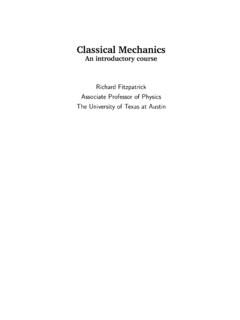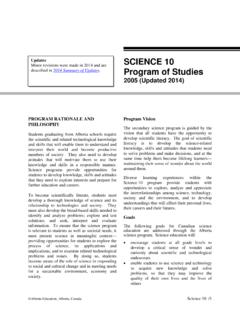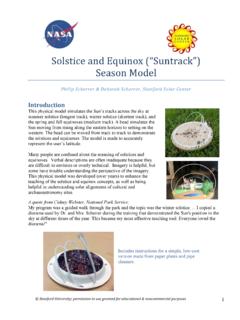Transcription of CHAPTER 4 FLOW IN CHANNELS - MIT OpenCourseWare
1 CHAPTER 4 FLOW IN CHANNELS introduction 1 Flows in conduits or CHANNELS are of interest in science, engineering, and everyday life. Flows in closed conduits or CHANNELS , like pipes or air ducts, are entirely in contact with rigid boundaries. Most closed conduits in engineering applications are either circular or rectangular in cross section. Open-channel flows, on the other hand, are those whose boundaries are not entirely a solid and rigid material; the other part of the boundary of such flows may be another fluid, or nothing at all.
2 Important open-channel flows are rivers, tidal currents, irrigation canals, or sheets of water running across the ground surface after a rain. 2 In both closed conduits and open CHANNELS , the shape and area of the cross section of the flow can change along the stream; such flows are said to be nonuniform. Flows are those that do not change in geometry or flow characteristics from cross section to cross section are said to be uniform. Remember that flows can be either steady (not changing with time) or unsteady (changing with time).
3 In this CHAPTER we will look at laminar and turbulent flows in conduits and CHANNELS . The emphasis in this CHAPTER is on steady uniform flow in straight CHANNELS . That s a simplification of flows in the natural world, in rivers and in the ocean, but it will reveal many fundamental aspects of those more complicated flows. The material in this CHAPTER is applicable to a much broader class of flows, in pipes and conduits, as well; such matters are covered in standard textbooks on fluid dynamics. 3 This CHAPTER focuses on two of the most important aspects of channel flow: boundary resistance to flow, and the velocity structure of the flow.
4 The discussion is built around two reference cases: steady uniform flow in a circular pipe, and steady uniform flow down an inclined plane. Flow in a circular pipe is clearly of great practical and engineering importance, and it is given lots of space in fluid-dynamics textbooks. Flow down a plane is more relevant to natural earth -surface settings (sheet floods come to mind), and it serves as a good reference for river flows. 4 The first section looks at laminar flow in a planar open channel, to derive expressions for the distributions of shear stress and velocity across the cross section.
5 There are two equivalent ways of doing that: specializing the Navier Stokes equations (which, remember, are a general 83 statement of Newton s second law as applied to fluid flows) to the given kind of flow, or writing Newton s second law directly for the given kind of flow. We will take the second approach here. Then in further sections we will tackle the much more difficult problem of resistance and velocity in turbulent flows in pipes and CHANNELS . That will necessitate a deeper examination of the nature of shear stresses in turbulent flow, and a careful consideration of the differences between what I will call smooth flow and rough flow.
6 The outcome will be some widely useful techniques as well as greatly increased understanding. The section on velocity distributions is intricate and lengthy, and may not seem as directly useful, but it reveals some really fundamental concepts. LAMINAR FLOW DOWN AN INCLINED PLANE 5 In this section we apply Newton s second law to steady and uniform flow down an inclined plane. The strategy is to look at a block of the flow, bounded by imaginary planes normal to the bottom, with unit cross-stream width and unit streamwise distance (Figure 4-1).
7 In fluid dynamics, such a block of fluid is said to be a free body . Because the flow is assumed to be steady and uniform, all of the forces in the streamwise direction that are exerted upon the fluid within the free body at any given time must add up to be to zero. 6 I should mention at the outset that for now I will not address how the flow is arranged so that the flow is uniform. If you just pour a sheet of water onto the plane along some particular horizontal line on the plane, you should not expect that uniform flow will automatically be established downslope of that line in the sense that the flow depth is the same at all normal-to-flow sections farther down the plane, and in general it is not: you would need to adjust the slope of the plane to attain a state of uniformity.
8 This is not a trivial problem, and it should await some more detailed material, later in this CHAPTER , on flow resistance. On the other hand, it should make intuitive sense to you that if the plane is very long the degree of nonuniformity would be very small whatever the slope: just imagine pouring water from a row of little faucets onto a plane a mile long and sloping a few degrees. 7 Obviously only liquids, not gases, can flow as open-channel flows. The freely deformable upper surface of the liquid, called the free surface, is open to the air.
9 We will neglect the minor forces exerted by the overlying air on the moving liquid. Our idealized channel flow is of infinite width, with no side boundaries, and it is therefore just a convenient abstraction. But a flow in a channel of rectangular cross section with the width of flow 84 much greater than the depth of flow is a good approximation to a flow with infinite width. 8 Take the x direction to be downstream and the y direction to be normal to the boundary, with y = 0 at the bottom of the flow (Figure 4-1). By the no-slip condition, the velocity is zero at y = 0, so the velocity must increase upward in the flow.
10 It is also clear that the flow is everywhere directed straight down the plane. Think about the forces acting on the fluid contained at a given instant in the free body within the rectangular volume formed by the free surface, the bottom boundary, and two pairs of imaginary planes normal to the bottom and with unit spacing, one pair parallel to the flow and spaced a distance B apart, and the other normal to the flow and spaced a distance L apart (Figure 4-1). Figure 4-1. Definition sketch for deriving the boundary shear stress in steady uniform flow down an inclined plane.


















